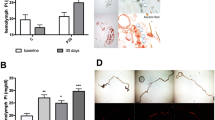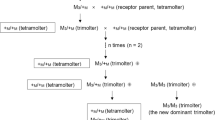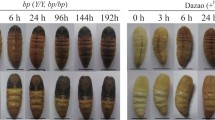Abstract
A variety of insects accumulate high contents of riboflavin (vitamin B2) in their Malpighian tubules (MTs). Although this process is known to be genetically controlled, the mechanism is not known. In the 1940s and the 1950s, several studies showed that riboflavin contents were low in the MTs of some Bombyx mori (silkworm) mutants with translucent larval skin mutations (e.g., w-3, od, oa, and otm) and that genes responsible for these translucent mutations also affected riboflavin accumulation in the MTs. Since the 2000s, it has been shown that the w-3 gene encodes an ABC transporter, whereas genes responsible for od, oa, and otm mutations encode for the biogenesis of lysosome-related organelles. These findings suggest that some genes of ABC transporters and biogenesis of lysosome-related organelles may control the accumulation of riboflavin in MTs. Therefore, we reexamined the effects that translucent mutations have on the accumulation of riboflavin in MTs by using the translucent and wild-type segregants in mutant strains to measure the specific effect that each gene has on riboflavin accumulation (independent of genomic background). We used nine translucent mutations (w-3oe, oa, od, otm, Obs, oy, or, oh, and obt) even though the genes responsible for some of these mutations (Obs, oy, or, oh, and obt) have not yet been isolated. Through observation of larval MTs and measurements of riboflavin content using high-performance liquid chromatography, we found that the oa, od, otm, and or mutations were responsible for low contents of riboflavin in MTs, whereas the Obs and oy mutations did not affect riboflavin accumulation. This indicates that the molecular mechanism for riboflavin accumulation is similar but somewhat different than the mechanism responsible for uric acid accumulation in epidermal cells. We found that the genes responsible for oa, od, and otm mutations were consistent with those already established for uric acid accumulation in larval epidermis. This suggests that these three genes control riboflavin accumulation in MTs through a mechanism similar to that of uric acid accumulation, although we do not yet know why the or mutation also controls riboflavin accumulation.


Similar content being viewed by others
References
Abraham EG, Sezutsu H, Kanda T et al (2000) Identification and characterisation of a silkworm ABC transporter gene homologous to Drosophila white. Mol Gen Genet 264:11–19
Aruga H, Eguchi M, Terao K (1952a) On riboflavin in the blood and Malpighian tubes in the larva of Bombyx mori. In: 4th Meeting of Kanto Branch of Japanese Society of Sericultural Science (in Japanese)
Aruga H, Yoshitake N, Eguchi M (1952b) Studies on the mechanism of the expressions of the translucent and lemon genes in the silkworm. (I) On the expressions of the translucent and lemon genes in the silkworm egg. J Seric Sci Jpn 21:255–263 (in Japanese with English summary)
Bacher A, Eberhardt S, Fischer M et al (2000) Biosynthesis of vitamin B2 (riboflavin). Annu Rev Nutr 20:153–167
Dadd RH (1985) Nutrition: organisms. In: Kerkut GA, Gilbert LI (eds) Comparative insect physiology, biochemistry and pharmacology, vol 4. Pergamon, Oxford, pp 313–390
Eguchi M (1955) Comparison of vitamin B2 contents in the blood and eggs between normal and od-translucent silkworms (Bombyx mori L.). J Seric Sci Jpn 24:350–352 (in Japanese with English summary)
Eguchi M (1956) Changes of the riboflavin content in several organs and tissues of od and normal silkworms, Bombyx mori during metamorphosis. Jpn J Genet 31:279–283
Fujii T, Daimon T, Uchino K et al (2010) Transgenic analysis of the BmBLOS2 gene that governs the translucency of the larval integument of the silkworm, Bombyx mori. Insect Mol Biol 19:659–667
Fujii T, Banno Y, Abe H et al (2012) A homolog of the human Hermansky-Pudluck Syndrome-5 (HPS5) gene is responsible for the oa larval translucent mutants in the silkworm, Bombyx mori. Genetica 140:463–468
Fujii T, Yamamoto K, Banno Y (2016) Molybdenum cofactor deficiency causes translucent integument, male-biased lethality, and flaccid paralysis in the silkworm Bombyx mori. Insect Biochem Mol Biol 73:20–26
Goldsmith MR, Shimada T, Abe H (2005) The genetics and genomics of the silkworm, Bombyx mori. Annu Rev Entomol 50:71–100
Ishihara R (1956) Studies on the Malpighian tubules of the silkworm, Bombyx mori L. (I) The accumulation of riboflavin in the Malpighian tubules and the riboflavin content of feces in the silkworm. J Seric Sci Jpn 25:135–140 (in Japanese with English summary)
Ishihara R (1958a) Studies on the Malpighian tubules of the silkworm, Bombyx mori L. (IV) Reciprocal transplantation of the Malpighian tubules between od-oily larva and normal larva. J Seric Sci Jpn 27:193–198 (in Japanese with English summary)
Ishihara R (1958b) Studies on the Malpighian tubules of the silkworm, Bombyx mori L. (V) Supplementary studies on the accumulation of riboflavin in the Malpighian tubules. J Seric Sci Jpn 27:374–381 (in Japanese with English summary)
Ishihara R (1958c) Studies on the Malpighian tubules of the silkworm, Bombyx mori L. (VI) Riboflavin content in the Malpighian tubules of several oily mutants. J Seric Sci Jpn 27:382–387 (in Japanese with English summary)
Ito K, Katsuma S, Yamamoto K et al (2009) A 25 bp-long insertional mutation in the BmVarp gene causes the waxy translucent skin of the silkworm, Bombyx mori. Insect Biochem Mol Biol 39:287–293
Kikkawa H (1948) On the tryptophan-pigment in the silkworm, Bombyx mori. Seibutsugaku no Shinpo. Tokyo Kyoritsu Press 3:36–70 (in Japanese)
Kiuchi T, Banno Y, Katsuma S et al (2011) Mutations in an amino acid transporter gene are responsible for sex-linked translucent larval skin of the silkworm, Bombyx mori. Insect Biochem Mol Biol 41:680–687
Kobayashi I, Uchino K, Iizuka T et al (2010) Rescue of the Aojuku white-egg translucent (w-3 ol) Bombyx mori mutant by transgenic expression of the wild-type Bmwh3 gene. J Insect Biotecnol Sericol 79:111–116
Kômoto N (2002) A deleted portion of one of the two xanthine dehydrogenase genes causes translucent larval skin in the oq mutant of the silkworm (Bombyx mori). Insect Biochem Mol Biol 32:591–597
Kômoto N, Sezutsu H, Yukuhiro K et al (2003) Mutations of the silkworm molybdenum cofactor sulfurase gene, og, cause translucent larval skin. Insect Biochem Mol Biol 33:417–427
Kômoto N, Quan GX, Sezutsu H et al (2009) A single-base deletion in an ABC transporter gene causes white eyes, white eggs, and translucent larval skin in the silkworm w-3 oe mutant. Insect Biochem Mol Biol 39:152–156
Koyanagi T, Hatamura M (1944) Relationship between the od translucency and flavin accumulation in the silkworm, Bombyx mori (Preceding report). Medicine Biology (Tokyo) 5:605–608 (in Japanese)
Ladenstein R, Fischer M, Bacher A (2013) The lumazine synthase/riboflavin synthase complex: shapes and functions of a highly variable enzyme system. FEBS J 280:2537–2563
Lin Y, Meng Y, Wang YX et al (2013) Vitellogenin receptor mutation leads to the oogenesis mutant phenotype “scanty vitellin” of the silkworm, Bombyx mori. J Biol Chem 288:13345–13355
Nakamura M, Yanagawa H, Kuarta K (1992) Homeostasis of vitamin B2 and role of the Malpighian tubes in the silkworm, Bombyx mori. J Seric Sci Jpn 61:52–58 (in Japanese with English summary)
Nickla H (1972) Interaction between pteridine synthesis and riboflavin accumulation in Drosophila melanogaster. Can J Genet Cytol 14:105–111
Sang JH (1956) The quantitative nutritional requirements of Drosophila melanogaster. J Exp Biol 33:45–72
Tamura T, Akai H (1990) Comparative ultrastructure of larval hypodermal cell in normal and oily Bombyx mutants. Cytologia 55:519–530
Tatematsu K, Yamamoto K, Uchino K et al (2011) Positional cloning of silkworm white egg 2 (w-2) locus shows functional conservation and diversification of ABC transporters for pigmentation in insects. Genes Cells 16:331–342
Tuan PA, Zhao S, Kim JK et al (2014) Riboflavin accumulation and molecular characterization of cDNAs encoding bifunctional GTP cyclohydrolase II/3,4-dihydroxy-2-butanone 4-phosphate synthase, lumazine synthase, and riboflavin synthase in different organs of Lycium chinense plant. Molecules 19:17141–17153
Van Breugel FM (1987) Differential riboflavin deposition in white and variegated white mutants of Drosophila hydei. Dev Genet 8:45–58
Wang L, Kiuchi T, Fujii T et al (2013a) Mutation of a novel ABC transporter gene is responsible for the failure to incorporate uric acid in the epidermis of ok mutants of the silkworm, Bombyx mori. Insect Biochem Mol Biol 43:562–571
Wang L, Kiuchi T, Fujii T et al (2013b) Reduced expression of the dysbindin-like gene in the Bombyx mori ov mutant exhibiting mottled translucency of the larval skin. Genome 56:101–108
Yuasa M, Kiuchi T, Banno Y et al (2016) Identification of the silkworm quail gene reveals a crucial role of a receptor guanylyl cyclase in larval pigmentation. Insect Biochem Mol Biol 68:33–40
Zhang H, Kiuchi T, Wang L et al (2017) Bm-muted, orthologous to mouse muted and encoding a subunit of the BLOC-1 complex, is responsible for the otm translucent mutation of the silkworm Bombyx mori. Gene 629:92–100
Zhang H, Kiuchi T, Hirayama C et al (2018) Bombyx ortholog of the Drosophila eye color gene brown controls riboflavin transport in Malpighian tubules. Insect Biochem Mol Biol 92:65–72
Acknowledgements
This study was in part supported by KAKENHI (15H02482, 24658048, and 22128004). The silkworm strains and related information were provided by National BioResource Project, Japan. We thank the anonymous reviewers for their criticism of the manuscript. We thank the Institute for Sustainable Agro-ecosystem Services, University of Tokyo, for facilitating the mulberry cultivation.
Author information
Authors and Affiliations
Corresponding author
Ethics declarations
Conflict of interest
The authors declare that they have no conflict of interest.
Electronic supplementary material
Below is the link to the electronic supplementary material.
Rights and permissions
About this article
Cite this article
Zhang, H., Kiuchi, T., Hirayama, C. et al. A reexamination on the deficiency of riboflavin accumulation in Malpighian tubules in larval translucent mutants of the silkworm, Bombyx mori. Genetica 146, 425–431 (2018). https://doi.org/10.1007/s10709-018-0034-y
Received:
Accepted:
Published:
Issue Date:
DOI: https://doi.org/10.1007/s10709-018-0034-y




